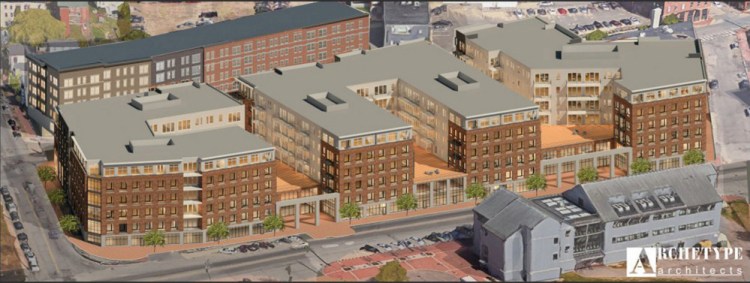A hotel and condominium complex planned for the Rufus Deering Lumber Co. site could add to traffic problems on Commercial Street and reduce parking that fishermen and other waterfront workers rely on, Portland residents and Planning Board members said Tuesday.
Steps are being taken to plan and fund traffic-relief projects on Commercial Street, the city’s transportation manager said at a Planning Board workshop Tuesday. But board Chairwoman Elizabeth Boepple said she doubts solutions will be found before hundreds of new hotel rooms and housing units are built along the waterfront, and she urged developers to reduce the number of housing units in the Rufus Deering project.
“I continue to have real issues with the scope and scale of this project,” Boepple said. “I continue to have concerns about those incremental increases impacting the quality of life for people who actually live here and tourists as well. It is hard to say we are going to address this by 2019, because I don’t think we can.”
The plan for 383 Commercial St. calls for a 139-room hotel and restaurant, 203 housing units, a 313-space parking garage and more than 21,000 square feet of retail space. The property is bordered by Commercial, High, York and Maple streets.
It would bring an additional 174 vehicles to the area during peak evening traffic hours, according to the developer’s traffic projection. About half would use Commercial Street, it estimated.
The Planning Board has held five workshops to consider the application by Reger Dasco Properties to redevelop the 2.6-acre property in three phases.
Board members have raised issues about public access through the property, parking and the design of the hotel, but traffic has emerged as a major concern.
Commercial Street is an important corridor for fishing and marine industries on the Portland waterfront, and much of its thriving tourism industry is centered on the area around Commercial Street. Those two uses are sometimes in conflict, particularly during the summer tourist season, when delivery trucks carrying perishable seafood must navigate through crowds of vehicles and pedestrians on Commercial Street.
In a petition to the Planning Board this summer, more than 90 lobstermen and other waterfront businesses warned that Commercial Street development would increase traffic and threaten their livelihood.
A section of Commercial Street in front of the Rufus Deering property carried an average of 15,160 vehicles daily in 2016, according to Maine Department of Transportation statistics. That is 660 vehicles fewer than in 2013 and significantly less than the 17,820 vehicles a day recorded in 2002.
On-street parking in front of Rufus Deering is used by waterfront workers who cannot park on the piers, where space is limited, city Waterfront Coordinator Bill Needelman told the board. Losing some or all those spots could create problems for waterfront businesses, he said.
Generally, the development at 383 Commercial St. should be considered in the broader context of challenges to the working waterfront, he said.
“The fishing community’s issues are significant, they are on target, and some are going to be easier to address than others,” Needelman said.
He asked the board to consider including the Rufus Deering project in a waterfront tax increment financing zone so real estate taxes it generates could be used for traffic improvements and waterfront projects.
Portland intends to start work on a Commercial Street Operations and Master Plan in 2018 to deal with traffic and other issues. A 2016 report recommended changes on Commercial Street west of the Old Port, including a planned traffic light at the High Street intersection.
Transportation Program Manager Bruce Hyman said the city is also working on better coordination between traffic lights where Commercial intersects with Union and Center streets to improve traffic flow, but acknowledged there are no immediate solutions.
“We don’t have a silver bullet lined up to address things and solve them next year, for example,” he said.
That answer seemed unsatisfactory for some Planning Board members and residents at Tuesday’s meeting.
“We have a massive traffic issue already,” said Jaye Van Dussen, who lives on High Street. “We don’t have a plan. Coordinating traffic lights is not a plan.”
Joe Dasco, a principal with Reger Dasco Properties, said the company would be open to reserving on-street parking for the working waterfront and would encourage retail tenants to validate parking in garages.
The traffic analysis by Sebago Technics played down the project’s impact on Commercial Street traffic. Steve Sawyer, a traffic engineer from Sebago Technics, said about half the peak hour traffic to and from the development would go onto York Street, which runs parallel to Commercial Street, limiting the impact on reducing congestion on Commercial.
Board member Carol Morrissette was skeptical. “I really question the 50 percent on York Street because it doesn’t pass the straight-face test,” Morrissette said.
She also worried about the project’s impact on local waterfront businesses.
“The working waterfront is down here, with all the stinky trucks and everything that goes along with it,” Morrissette said. “I just don’t think it is fair to take a development of this scale, particularly with its focus on a hotel, at the expense of the waterfront’s working citizens.”
Peter McGuire can be contacted at 791-6325 or at:
pmcguire@pressherald.com
Twitter: @PeteL_McGuire
Send questions/comments to the editors.



